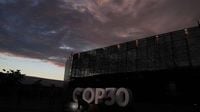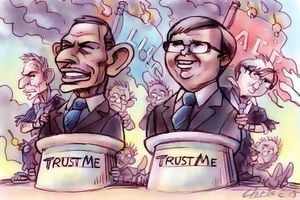Ten years after the world’s historic embrace of the Paris Agreement, the planet finds itself at a crossroads—one marked by both hard-won progress and mounting peril. In December 2015, nearly every country on Earth pledged to cut emissions to net zero by 2050, aiming to keep global temperature rise below 1.5 degrees Celsius above pre-industrial levels. The mood in Paris was jubilant: diplomats wept, a green gavel struck the desk, and the world seemed poised to turn the tide on climate change. Yet, as delegates gather in Belém, Brazil for the United Nations COP30 summit, the gap between ambition and reality has never felt starker.
Over the last decade, the world has emitted roughly 300 gigatons of carbon, according to CNN. The consequences have been both dramatic and devastating. The last ten years have been the hottest on record, with global temperatures jumping by about 0.46°C since 2015, as reported by Europe’s Copernicus Climate Service. Each year since the Paris accord has been warmer than the last, and 2025 is expected to be among the top three hottest years ever recorded.
Extreme weather events have become a grim new normal. The United States alone has suffered 193 weather disasters costing at least $1 billion each over the past decade, totaling $1.5 trillion in damages, according to the US National Oceanic and Atmospheric Administration. Hurricanes have battered Puerto Rico and Jamaica—the latter struck in October 2025 by the most powerful Atlantic storm on record. Floods have upended lives in Pakistan and China, wildfires have ravaged Hawaii, California, Europe, and Australia, and rising seas are swallowing coastlines from the Pacific to the Atlantic.
The physical changes are staggering. More than 7 trillion tons of ice have melted from Greenland and Antarctica since 2015, raising sea levels by 40 millimeters—enough to fill 30 Lake Eries, as University of Colorado scientist Steve Nerem explained. Even the Amazon rainforest, once a vital carbon sink, has at times emitted more carbon than it absorbs, a bitter irony as world leaders meet in the heart of the region.
Despite these danger signals, there have been genuine advances. Renewable energy has outpaced expectations. In the first half of 2025, renewables overtook coal as the world’s top energy source for the first time, with wind and solar expected to meet 90% of new electricity demand this year, CNN reported. Last year, 74% of new electricity generation globally came from renewables, according to two UN reports. Electric vehicle sales have soared from half a million in 2015 to 17 million in 2024.
“The transition is moving even faster than people predicted back in 2015,” said Jamie Henn, co-founder of 350.org and director of Fossil Free Media. Solar power installations, for instance, are happening fifteen times faster than experts anticipated a decade ago, according to the non-profit Energy and Climate Intelligence Unit. “There’s no stopping it,” added Todd Stern, former US Special Climate Envoy and chief negotiator of the Paris deal. “You cannot hold back the tides.”
Public sentiment is also shifting. A 2024 global survey found that 89% of people favored stronger political action on climate change, as CNN highlighted. Mark Hertsgaard, executive director of Covering Climate Now, called it a “supermajority that doesn’t know that it’s a majority.” In the United States, 79% of registered voters polled in May 2025 supported remaining in the Paris Agreement, and 75% backed regulating carbon dioxide as a pollutant.
Yet, emissions are still rising. Methane in the atmosphere is up 5.2% and carbon dioxide by 5.8% since 2015, according to NOAA data. While the US and other developed nations have managed to cut their CO₂ emissions by about 7%, China’s emissions have grown by 15.5% and India’s by nearly 27%, reflecting both economic growth and a reliance on coal. Oxfam International points out a stark disparity: the richest 0.1% of the global population increased their emissions by 3% over the decade, while the poorest 10% reduced theirs by 30%.
The Paris Agreement’s central goal—to limit warming to 1.5°C—now appears out of reach. UNEP warns that current policies are steering the world toward 2.8°C of warming, far above the Paris target. “I think it’s important that we’re honest with the world and we declare failure,” said Johan Rockström, director of the Potsdam Institute for Climate Research, in remarks to agencies. “The harms of warming are happening faster and more severely than scientists predicted.”
Former UN climate chief Christiana Figueres, who helped broker the 2015 accord, acknowledged the widening gap between progress and necessity. “We’re actually in the direction we established in Paris at a speed that none of us could have predicted,” she said. “But the gap between the progress we see on the ground and where we ought to be is still there and widening.” UNEP Executive Director Inger Andersen was even more blunt: “We’re sort of sawing the branch on which we are sitting.”
Still, some climate advocates see reasons for hope. At the COP meeting in Dubai in 2023, world leaders added explicit language to the Paris Agreement calling for a move away from fossil fuels. “We really reached a pinnacle in terms of addressing the root causes of the climate emergency,” said Jean Su, energy justice director at the Center for Biological Diversity. New initiatives are on the horizon, including a push for a Fossil Fuel Nonproliferation Treaty. Alex Rafalowicz, executive director of that initiative, said, “The economics do demonstrate that the transition [to clean energy sources] has an inevitability about it. But the question is whether it is fast enough, and whether it is fair enough. That is part of the problem we’re trying to solve.” A meeting about the treaty is likely to happen next spring in Colombia.
As COP30 opens in Brazil on November 10, 2025, negotiators face a sobering reality. The last decade has shaved more than a degree Celsius off future warming projections, but the world is still far from safety. A joint report by the Bezos Earth Fund, Climate Analytics, ClimateWorks Foundation, and the World Resources Institute found that while 35 key indicators of decarbonisation are trending positively, none are on track to keep warming below the Paris threshold. UN Secretary-General António Guterres has repeatedly called the situation “deadly negligence,” urging governments to accelerate the transition before the damage becomes irreversible.
In Paris, the rallying cry was “1.5 to stay alive.” Today, the world must grapple with the reality that every ton of emissions avoided still makes a difference. The optimism and urgency of that green gavel moment have not been forgotten, but the next chapter will be written by the choices made now—in Belém and beyond.




